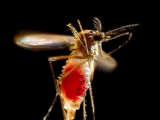Oct 10, 2012
West Nile outbreak waning, CDC report shows
The latest update from the US Centers for Disease Control and Prevention (CDC) suggests that this year's major West Nile virus outbreak is fading, with 280 cases and 5 deaths reported in the past week. That compares with 424 cases and 16 deaths the previous week, which had marked a slight uptick from the week before. Cases for this year now total 4,249, with 168 deaths, which is the most for this time of year since 2003, according to the CDC. Fifty percent (2,123) of the cases have been West Nile neuroinvasive disease, the most serious form. Texas has had 1,520 cases, about 36% of the national total, with 54 deaths. The CDC said, as it has noted before, that nearly 70% of the cases occurred in eight states: Texas, California, Louisiana, Mississippi, South Dakota, Michigan, Oklahoma, and Illinois. The 280 cases in the past week include 113 cases of neuroinvasive disease.
CDC weekly WNV
update
WHO: No further novel coronavirus infections
No new infections with a novel coronavirus have been reported, and so far monitoring of close contacts of the only two confirmed cases has found no sign of human-to-human transmission of the virus, the World Health Organization (WHO) said in an update today. Infectious disease officials in Saudi Arabia, Qatar, and the United Kingdom are continuing their investigations into the virus and its source. The WHO said it is supporting those efforts and has sent its experts to Saudi Arabia and Qatar as members of an international team. Yesterday the UK's Health Protection Agency (HPA) said no new cases have been reported in that country and that the second case-patient, a man from Qatar, is still being treated in an intensive care unit of a London hospital. John Watson, MB BS, head of the HPA's respiratory diseases department, said in a statement that though it's reassuring that the 50 to 60 of the patient's close contacts have no evidence of
infection, further studies are being done, including serum testing to determine if some of the contacts had mild or asymptomatic infections.
Oct 10 WHO update
Oct 9 HPA statement
Study: Flu can trigger myocardial infarction
Acute respiratory infections, especially influenza, can act as a trigger for acute myocardial infarction (AMI), say the findings of a study from London published yesterday in the Journal of Infectious Diseases. The study group comprised 11,208 patients who experienced AMI from Jan 1, 2003, to Jul 31, 2009, and were 40 years of age or older at the age of first AMI. The authors analyzed their records to determine whether there was any association of AMI in the group with acute respiratory infection (ARI). They found that 3,927 (35.0%) of the AMI patients had been seen for ARI during the study period. These patients had 8,204 episodes of ARI (mean, 2.1 per person), their median age was 73.1 years, and 60% were male. The authors found that the risk of AMI was substantially higher during the first 3 days after ARI (adjusted incidence ratio, 4.19 [95% confidence interval (CI), 3.18-5.53), an effect that tapered over time. The risk was
highest in older patients, with an adjusted incidence ratio in patients 80 and older of 5.94 (95% CI, 3.90-9.04) for AMI in the 3 days following ARI. Patients whose respiratory infection records contained at least one indicator of influenza (eg, occurrence temporally related to peaks in flu incidence, coding for influenza-like illness) also had a significantly greater risk of AMI than those without any indicators (incidence ratio, 5.39 [95% CI, 3.89-7.45] vs 2.38 [95% CE, 1.37-4.11; P = .012]). The authors point out that flu vaccine uptake is often poor in high-risk groups such as those with cardiac disease and state that their study "adds to the evidence to support increased efforts to maximize uptake of influenza vaccination in these groups to protect against cardiovascular complications of influenza."
Oct 9 J Infect Dis study abstract
Oct 9 J Infect Dis editorial extract
CSL details findings on Fluvax-linked seizures in kids
An ongoing investigation by scientists from Australia's CSL Biotherapies still hasn't revealed the cause of increased febrile seizures in some young Australian children who received CSL's Fluvax seasonal flu vaccine in 2010, but researchers suspect it could relate to the introduction of three new strains or manufacturing processes. As reported in Vaccine, the researchers tested CSL's 2010 vaccine and its components, comparing the findings with another company's flu vaccine made that year for the Southern Hemisphere, CSL's vaccine for the Northern Hemisphere's 2009-10 season, another company's vaccine for the 2010-11 Northern Hemisphere season, and a reengineered version of its 2010 vaccine that replaced the 2009 H1N1 strain with the former seasonal H1N1 strain. They did pyrogenicity testing in rabbits, ferrets, newborn mice, and nonhuman primates. In addition, they explored in vitro cytokine induction using adult and
pediatric whole blood. The blood assays and the nonhuman primate studies suggested that CSL's trivalent flu vaccines induce higher levels of cytokines and chemokines, with 2009 H1N1 and the influenza B Brisbane strain as the major contributors, compared with vaccines from other manufacturers. The authors reported that studies are ongoing and may identify surrogate parameters that will help with formulating future vaccines that minimize the risk of febrile reactions in kids. CSL's investigation also includes a clinical safety arm and manufacturing and quality assessments.
Oct 9 Vaccine abstract



















